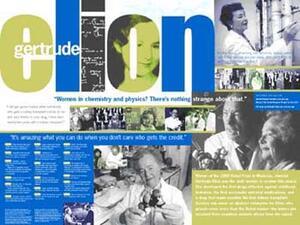Posters in the classroom: Outdated or just underused?
Earlier this week in The Sisterhood, Renee Ghert-Zand discussed Keshet’s new poster series recognizing “Jewish LGBT Change Makers,” asking if posters were an outdated educational tool. Renee drew comparisons to JWA’s own Women of Valor poster series, and expressed concern that Keshet’s posters would face the same challenges that she saw with ours. She wrote:
The similarity is both good and bad. It’s a good thing because I have always loved the JWA posters. They began being published when I was early in my teaching career, and were a great educational resource. “What an attractive and attention-grabbing way to introduce students to historical figures like Glikl of Hameln, Rebecca Gratz, Molly Picon and Emma Lazarus,” I thought.
…When I began working as director of education at a large synagogue, I found several pinned up on bulletin boards. They were faded and frayed from having been used as class decorations for years – with the operative word here being “decorations.” None of the teachers in whose rooms the posters hung could recall having ever really using them in their teaching.
The women’s posters were underutilized not because of a lack of curricular resources to go with them. Rather, it was due to a lack of interest among educators for intentionally curricularizing Jewish women’s history. With so much to teach in so little time, Jewish women history makers were literally and figuratively left in the closet.
We at JWA were delighted to see that the Women of Valor poster series, one of JWA’s first projects, is still generating discussion and we’re grateful to Renee for bringing up some of the limitations that still exist. As some commenters pointed out, both the Women of Valor and Jewish LGBT Change Makers posters have accompanying web exhibits (Women of Valor online and LGBT Jewish Heroes online) with additional resources for educators. Still, there are a number of ways to incorporate the posters themselves into classroom learning.
In the education section of jwa.org, we share Best Practices for using JWA materials. We offer some suggestions of our own for incorporating the posters into programming at schools, synagogues, libraries, college campuses, and adult education settings. On our "Ideas from the Field" page, educators can share their experiences using the Women of Valor posters in a variety of settings. Some examples are listed below; visit Ideas from the Field for more.
-
Ames Jewish Congregation Religious School in Ames, Iowa laminated the posters and put them in a central area in the school. One of the older classes was asked to come up with questions based on the women portrayed in the posters. The quiz was posted and the contest was announced and publicized in the school. Winners were awarded their prizes and their names posted.
-
Grades three through six at Eliahu Academy in Louisville, KY created a timeline of American History aimed at filling the gaps in our history. Women of Valor materials were helpful in providing students and teachers with resources to begin filling in these gaps.
-
Jewish Girl Scouts of Chaparral Council in Albuquerque, NM inducted Henrietta Szold and Rose Schneiderman into their Famous Jewish Women Hall of Fame. They studied the women, created their own posters on these and other Jewish women, and dressed up as the heroines they had researched at a celebratory event honoring Jewish women of achievement.
Of course, the biggest obstacle to using the poster series as an educational tool is not a lack of creativity on the educator’s part, but as Renee Ghert-Zand identified, a systemic resistance to--or lack of interest in--changing curricula to include Jewish women (and we can assume Jewish LGBT Change Makers too). Of course, changing the status quo does not happen overnight. And that’s why the work of the Jewish Women’s Archive, Keshet, and other organizations dedicated to inclusion within Jewish education and Jewish life is so important.
If your Women of Valor posters are faded and frayed, buy a new set (or single poster) at jwa.org and help support the work that is moving us toward a more inclusive future. You can also pick up the first three Jewish LGBT Change Makers posters from Keshet.
How do you use posters and other visual aids in the classroom? If you have ideas or best practices, please share them in the comments!







It has been a while since I visited jwa.org, but the first time I was exposed to this organization was through the Women of Valor poster series. I was working on a project that would take complex Jewish ideas and break them down into engaging pieces of printed media that could be used in a classroom setting. The Women of Valor posters became my "go-to" in terms of best practices for typography, layout, content, and use of color as a differentiator between posters within the series. I thought (and still think) that the posters are an excellent teaching tool and a superb example of information graphic design. I thought the above thread was interesting in terms of feedback on limited use within a classroom setting, and I'd like to counter some of the ideas expressed in this article with my own examples.
I've used the tool of information graphics, "infographics", as a vehicle for breaking down multiple levels of information and clearly explaining concepts and ideas. While today's students (young and old) tend to be bombarded with digital forms of media, I think there is still a valid and important place for static graphics in the mix of educational materials. While a presentation and interactive digital experience provide movement and responsiveness, the printed piece is static and consistent. It allows someone to gaze at it, and take in information through a more iterative process. Each time they look at the piece, they may see something different, and ideas and concepts begin to create cognitive connections as a person absorbs the information presented through the design hierarchy. Learning information in this manner is a helpful adjunct to auditory learning as it helps reinforce concepts and ideas. I would like to see more materials created for the Jewish Studies classroom that use the same format as the Women of Valor posters and provide instruction and suggestions on how a teacher can engage the students through these beautiful teaching materials. I think there is a strong need across the board for alternative methods of communication and content distribution, and the printed poster can serve as a valuable tool within an educator's collection of teaching material.
As an anecdote (and this is not something I've tested), I know that my children have benefitted from some of the more popular printed materials that their schools display on the classroom walls. For instance, there is a popular "Sea of Halacha" poster that uses the analogy of tributaries, rivers, and oceans to show the correlation between the generations of biblical commentaries that have developed Halacha throughout the generations. Seeing a linear map of these names and dates, and understanding how each individual contributed to the scholarly conquest of their successor has helped place a myriad of personalities and biblical texts within an easy-to-understand context.
I'd love to see more of these types of materials, on a wide range of topics within Jewish Studies. As we strive to find ways to connect with our generation of tech-savvy content consumers, adding static printed graphics is an invaluable part of disseminating content.